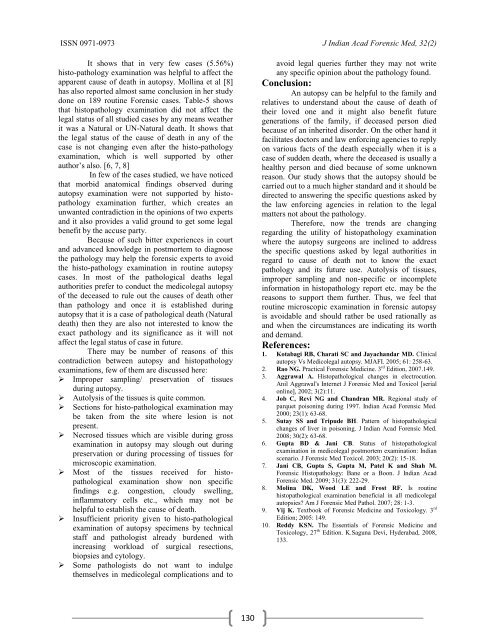jiafm, 2010-32(2) april-june. - forensic medicine
jiafm, 2010-32(2) april-june. - forensic medicine
jiafm, 2010-32(2) april-june. - forensic medicine
- No tags were found...
You also want an ePaper? Increase the reach of your titles
YUMPU automatically turns print PDFs into web optimized ePapers that Google loves.
ISSN 0971-0973 J Indian Acad Forensic Med, <strong>32</strong>(2)It shows that in very few cases (5.56%)histo-pathology examination was helpful to affect theapparent cause of death in autopsy. Mollina et al [8]has also reported almost same conclusion in her studydone on 189 routine Forensic cases. Table-5 showsthat histopathology examination did not affect thelegal status of all studied cases by any means weatherit was a Natural or UN-Natural death. It shows thatthe legal status of the cause of death in any of thecase is not changing even after the histo-pathologyexamination, which is well supported by otherauthor‟s also. [6, 7, 8]In few of the cases studied, we have noticedthat morbid anatomical findings observed duringautopsy examination were not supported by histopathologyexamination further, which creates anunwanted contradiction in the opinions of two expertsand it also provides a valid ground to get some legalbenefit by the accuse party.Because of such bitter experiences in courtand advanced knowledge in postmortem to diagnosethe pathology may help the <strong>forensic</strong> experts to avoidthe histo-pathology examination in routine autopsycases. In most of the pathological deaths legalauthorities prefer to conduct the medicolegal autopsyof the deceased to rule out the causes of death otherthan pathology and once it is established duringautopsy that it is a case of pathological death (Naturaldeath) then they are also not interested to know theexact pathology and its significance as it will notaffect the legal status of case in future.There may be number of reasons of thiscontradiction between autopsy and histopathologyexaminations, few of them are discussed here:‣ Improper sampling/ preservation of tissuesduring autopsy.‣ Autolysis of the tissues is quite common.‣ Sections for histo-pathological examination maybe taken from the site where lesion is notpresent.‣ Necrosed tissues which are visible during grossexamination in autopsy may slough out duringpreservation or during processing of tissues formicroscopic examination.‣ Most of the tissues received for histopathologicalexamination show non specificfindings e.g. congestion, cloudy swelling,inflammatory cells etc., which may not behelpful to establish the cause of death.‣ Insufficient priority given to histo-pathologicalexamination of autopsy specimens by technicalstaff and pathologist already burdened withincreasing workload of surgical resections,biopsies and cytology.‣ Some pathologists do not want to indulgethemselves in medicolegal complications and toavoid legal queries further they may not writeany specific opinion about the pathology found.Conclusion:An autopsy can be helpful to the family andrelatives to understand about the cause of death oftheir loved one and it might also benefit futuregenerations of the family, if deceased person diedbecause of an inherited disorder. On the other hand itfacilitates doctors and law enforcing agencies to replyon various facts of the death especially when it is acase of sudden death, where the deceased is usually ahealthy person and died because of some unknownreason. Our study shows that the autopsy should becarried out to a much higher standard and it should bedirected to answering the specific questions asked bythe law enforcing agencies in relation to the legalmatters not about the pathology.Therefore, now the trends are changingregarding the utility of histopathology examinationwhere the autopsy surgeons are inclined to addressthe specific questions asked by legal authorities inregard to cause of death not to know the exactpathology and its future use. Autolysis of tissues,improper sampling and non-specific or incompleteinformation in histopathology report etc. may be thereasons to support them further. Thus, we feel thatroutine microscopic examination in <strong>forensic</strong> autopsyis avoidable and should rather be used rationally asand when the circumstances are indicating its worthand demand.References:1. Kotabagi RB, Charati SC and Jayachandar MD. Clinicalautopsy Vs Medicolegal autopsy. MJAFI. 2005; 61: 258-63.2. Rao NG. Practical Forensic Medicine. 3 rd Edition, 2007.149.3. Aggrawal A. Histopathological changes in electrocution.Anil Aggrawal's Internet J Forensic Med and Toxicol [serialonline], 2002; 3(2):11.4. Job C, Revi NG and Chandran MR. Regional study ofparquet poisoning during 1997. Indian Acad Forensic Med.2000; 23(1): 63-68.5. Sutay SS and Tripude BH. Pattern of histopathologicalchanges of liver in poisoning. J Indian Acad Forensic Med.2008; 30(2): 63-68.6. Gupta BD & Jani CB. Status of histopathologicalexamination in medicolegal postmortem examination: Indianscenario. J Forensic Med Toxicol. 2003; 20(2): 15-18.7. Jani CB, Gupta S, Gupta M, Patel K and Shah M.Forensic Histopathology: Bane or a Boon. J Indian AcadForensic Med. 2009; 31(3): 222-29.8. Molina DK, Wood LE and Frost RF. Is routinehistopathological examination beneficial in all medicolegalautopsies? Am J Forensic Med Pathol. 2007; 28: 1-3.9. Vij K. Textbook of Forensic Medicine and Toxicology. 3 rdEdition; 2005: 149.10. Reddy KSN. The Essentials of Forensic Medicine andToxicology, 27 th Edition. K.Saguna Devi, Hyderabad, 2008,133.130



![syllabus in forensic medicine for m.b.b.s. students in india [pdf]](https://img.yumpu.com/48405011/1/190x245/syllabus-in-forensic-medicine-for-mbbs-students-in-india-pdf.jpg?quality=85)



![SPOTTING IN FORENSIC MEDICINE [pdf]](https://img.yumpu.com/45856557/1/190x245/spotting-in-forensic-medicine-pdf.jpg?quality=85)

![JAFM-33-2, April-June, 2011 [PDF] - forensic medicine](https://img.yumpu.com/43461356/1/190x245/jafm-33-2-april-june-2011-pdf-forensic-medicine.jpg?quality=85)



![JIAFM-33-4, October-December, 2011 [PDF] - forensic medicine](https://img.yumpu.com/31013278/1/190x245/jiafm-33-4-october-december-2011-pdf-forensic-medicine.jpg?quality=85)


